 La Laja is a major rock art concentration on a large outcrop wall high above the Majes River valley in southern Peru. This article describes the many rock art images at La Laja and attempts at a tentative chronology. Most of the imagery belongs to the Majes Rock Art Style (see Van hoek 2018 for more information), although several images are later.
La Laja is a major rock art concentration on a large outcrop wall high above the Majes River valley in southern Peru. This article describes the many rock art images at La Laja and attempts at a tentative chronology. Most of the imagery belongs to the Majes Rock Art Style (see Van hoek 2018 for more information), although several images are later.
By Maarten van Hoek
*
*
The Rock Art Site of La Laja
Majes Valley, Peru
*
Maarten van Hoek
Introduction
Every inhabited continent has enormous amounts of valuable and irreplaceable rock art, but the Majes Valley of southern Peru undoubtedly houses the biggest rock art concentration of South America. More than 30 rock art sites have been recorded in this valley and its side-valleys, of which Toro Muerto is by far the largest rock art group. A minimum of 2584 decorated boulders have been recorded at Toro Muerto so far (February 2022). But also Alto de Pitis – a major rock art site opposite Toro Muerto – is of key importance, encompassing probably around 500 decorated boulders. All other sites in the valley have a much more limited number of decorated panels or just comprise only one decorated boulder or just one outcrop panel. Yet, a limited number of panels does not mean that there are only few rock art images. This is evidenced by the rock art site of La Laja, the subject of this study.
Figure 1: The location of the rock art site of Laja. Map © by Maarten van Hoek, map © by OpenStreetMap – Contributors.
Click on any illustration to see an enlargement. Click on the enlargement to return to my TRACCE web page.
La Laja – The Location
The petroglyph site of La Laja is found on the east bank of the Majes Valley (Figure 1), about 66 km inland from the point where the river Majes empties its waters into the Pacific Ocean. Although La Laja is definitely part of the Majes Culture that created most of the rock art in the valley (and beyond; see Van Hoek 2018), the site has a rather unusual position. Although several sites in the Majes Valley are rather difficult to reach and to explore, La Laja is a true anomaly, as it is positioned exceptionally high above the valley floor (which is at 570 m asl at that point). Notably, the decorated panels of La Laja are found 320 m above the valley floor (not 700 m as stated by Hostnig [2003: 51]) at an altitude of 890 m asl (Figure 2).
Figure 2: The location of the rock art site of La Laja in the Majes Valley. Drawing © by Maarten van Hoek, based on Google Earth.
Figure 3: The location of the rock art site of La Laja. The steep path leading up to the site is clearly visible (the site itself is invisible). Photograph © by Maarten van Hoek.
The ascent to La Laja involves a very steep, almost diagonal climb of about 700 m in length (Figure 3) in order to reach the decorated panels that only become visible when having reached the top of the slope. The uphill scramble is extra difficult and exhausting because of the extremely loose sands. Therefore it took me about 50 minutes to reach the site (in scorching sunlight). On the other hand, the descent only took five minutes (in full speed!). Until 12.00 a.m. the cliff-site is in the shade, making surveying the perpendicular panels in the morning hours much more comfortable. After noon the intense sunlight obscures more than it reveals (Figure 4), as even the slanting sunlight blurs more than it (usually) exposes because of the strong, reflection of the white, almost blinding sands at the foot of the decorated cliff-face.
Figure 4: Panel at La Laja photographed before (right) and just after noon (left). Photographs © by Maarten van Hoek.
The rock art of La Laja is also exceptional because it represents the largest concentration of petroglyphs on outcrop rock in the Majes Valley (most sites in the valley comprise boulders only or a mix of [mainly] boulders and [some] outcrops). Moreover, the images at La Laja are found densely concentrated on a long, deeply patinated cliff wall, the decorated part of which measures about 25 m from north to south. It is mainly the lower part of the vertical wall that is decorated. The petroglyphs are most densely concentrated in the lower part, but may occasionally extend upwards to a height of about 2.50 m. The lower part of the cliff is covered by sand that in places conceals rock art, although the depth of the possibly covered images may vary along the cliff. The greater part of the cliff-panels are facing to the west, although a few, mainly small panels face to the WSW and one even to the south (see Figure 11). At the foot of the cliff is a rather narrow ledge (up to two meters wide) comprising loose sands that covers an (unknown) number of petroglyphs. Immediately adjacent (west of) this rather narrow ledge of sand is the steep slope and therefore it is impossible to photograph the entire cliff as a whole without a drone (which I never used).
Because of its elevated position there are wide views across this part of the Majes Valley. About 7 km to the SW the rock art sites of Querullpa are visible (that is, if one knows where the sheltered rock art is located), while to the west one overlooks the valley floor towards the archaeological site of La Real. The views to the NW are blocked by the neighbouring hill and for that reason Apu Coropuna (perhaps the most important Sacred Mountain of this part of the Andes) is not visible. Instead, the otherwise fine view to the NW is blocked by the pinnacles of an impressive rock formation, called Los Monjes (Figure 5). It is important to mention that a couple of meters above the petroglyphs of La Laja there is a small, almost inaccessible ledge with some ancient tombs, called “Tumbas Colgantes” by Condori Pacheco (2008: 31).
Figure 5: View from La Laja looking NW towards Los Monjes. The small clouds are generated by the (invisible) volcano (Apu) Coropuna. Photograph © by Maarten van Hoek.
*
History of Recording
It is actually unknown who first discovered the rock art site of La Laja, but it is possible that the site (referred to by Linares Málaga as “Huancarqui – La Lapa”) was first indicated on a (confusing) map published by Eloy Linares Málaga, called “Principales Centros de Arte Rupestre en el Sur del Perú – 1951-1972” (Linares Málaga 1973-2013; Fig. 58). If this reference indeed concerns La Laja, then the site was known before 1972. But as Linares Málaga only (very briefly) mentions La Laja (1973-2013: 644) with regard to portable rock art (lajas pintadas), it is doubtful whether he knew of the petroglyph site (see also Linares Málaga 2004: 50 – Entry 120: La Laja; “sitio recientemente investigado”)
Remarkably, only very few publications mention or describe the rock art of La Laja (none mentioning its discoverer), especially when compared with the plethora of publications about nearby Toro Muerto. The site was first mentioned in the Inventario Nacional by Rainer Hostnig (2003: 50-51), who was informed about the site by Paúl Álvarez Zeballos in May 2003. In his entry Hostnig refers to Ravines (1967-68: 310 – 319) and to Linares (1992a: 372, 373; 1999: 112), but I could not find any information about La Laja in the book by Rogger Ravines (which has only 88 pages), while the data provided by Linares Málaga may well have been based on hear-say information. In 2008 the site was very briefly described in a report about the (touristic) potential of the Provincia de Castilla, directed by Condori Pacheco (2008: 31).
It was Álvarez Zeballos who published the first rather extensive report about La Laja (2009: 4, 13, 45 – 50) together with a selection of photographs. Although informative, the text does not cover all features and/or details that have been manufactured at La Laja and his remarks about the chronology are – in my opinion – outdated (as are my own remarks in my 2013-publication).
In 2013 I published a book analysing the reason for the “unexpected” plethora of “Carcancha” petroglyphs at Alto de Pitis, in which also some aspects of the imagery of La Laja were described (2013: 50 – 52). La Laja is also mentioned in a publication by Rosińska (2016). I also briefly mentioned and illustrated La Laja in my book about the rock art at Quilcapampa (Van Hoek 2021b). Also in 2021 Richard Manuel Ochoa Peña published a short article on La Laja (Ochoa Peña 2021). Finally, a full inventory of La Laja based on a scientific survey was never published and also this study does not pretend to offer such an inventory. However, this study is based on a full and detailed photographic record that I made of the site in 2009.
Nearby Rock Art Sites
La Laja is located between two close-by rock art sites. A short distance to the north, in the valley east of the village of Huancarqui once was a small group of boulders at a spot called Huancarqui Cementerio, said to bear petroglyphs, but completely destroyed many years ago (therefore the location has only been estimated in Figure 2). I know of at least one decorated panel to have been present among the boulders. It showed a number of images that are typical for the Majes Rock Art Style (henceforth called MRAS; for more information see Van Hoek 2018).
Only 1560 m to the SSW of La Laja is one of the two known rock art sites in the Majes Valley having pictographs (ignoring here the fact that Alvarez Zeballos [2009: 4] has erroneously described the rock art at La Laja as pictographs (pictografias). It concerns the site of Chancharay (first reported in 2021 by archaeologist Katherine Lisseth Zuzunaga Palacios of SV Arqueólogos – Empresa Consultora en Arqueología – Lima, Perú) where mainly abstract, multi-coloured designs and a few simple, monochromatic anthropomorphic figures have been reported on a large number of rather small panels of a much fragmented outcrop cliff just above the floodplain of the Río Majes. Importantly, as far as I can tell, the art at the whole complex not really represents an expression of the MRAS. The other site with pictographs in the valley, Querullpa (on the west bank), has an intriguing mixture of MRAS petroglyphs, pictographs and even petroglyphs hacked out in a previously red-painted surface, all on outcrop panels at almost inaccessible positions.
Directly opposite La Laja and visible from the site, is the rock art site of Caspani or Kaspani (located on the west bank), perhaps also known as La Culata (de Aplao), of which Linares Málaga (1990: 422) includes a few drawings that indicate that at least a few zoomorphic petroglyphs at that site are of the MRAS (depicting quadrupeds and birds). Importantly, a short distance to the south of Kaspani is the intriguing Pre-Columbian cemetery of La Real (or Yupanqui).
Álvarez Zeballos, who published the first report on La Laja (2009), claims that nine panels at La Laja bear petroglyphs, although he only (briefly) describes eight panels. The first (northernmost) panel that he included, has not been described by him, probably because no petroglyphs are visible. However, there might be one large and roughly executed zoomorphic petroglyph on this panel, while moreover much of the lower part of the panel is covered by sand, possibly hiding rock art. Including this possibly “empty” panel, I distinguished at least ten panels with petroglyphs, but the difference in panel-numbers may have arisen from a different interpretation of the term “panel”. Because – in the long run – it actually proved to be irrelevant exactly on which panel the images are found, I will treat the entire decorated part of the cliff-face as a whole, except for the two southernmost panels, which – in my opinion – may have been manufactured somewhat later.
Because several petroglyphs are often (partly or completely) covered by the loose sands at the bottom of the cliff and because of ongoing weathering and erosion, the exact number of images once manufactured in prehistoric times at this site is unknown. Moreover, despite its hard-to-reach location several panels have suffered severely from vandalism, most likely by locals from the valley (I even have a photo showing a plastic bottle wedged into one of the cracks). For those reasons the numbers stated in this study only represent the very minimum.
Yet I managed to count about 233 recognisable petroglyphs at La Laja, involving at least 166 quadrupeds; 28 birds; 16 anthropomorphic figures; six snakes, while the remainder comprises a few zigzags, some indeterminable images, at least two rayed solar motifs, some rectangular and curvilinear meanders, a number of (concentric) circles (with or without a central dot or internal pecking), two fully pecked square areas, several randomly running grooves, one grid and at least one fully pecked petroglyph (Element 1 in Figure 6) depicting the high-status symbol of the “Insignia Tumi” (Van Hoek 2016). Besides those readily identifiable petroglyphs there also are numerous, often small amorphous, yet anthropic markings (some possibly representing unfinished biomorphic figures) that are distributed randomly across the panels. Concluding, I very tentatively estimate the number of anthropic markings at La Laja to range between 250 and 350.
Figure 6: Petroglyphs at La Laja, Majes Valley, Peru. Photographs © by Maarten van Hoek.
*
QUADRUPEDS
Indeed, the great majority of the biomorphic images at La Laja comprises images of quadrupeds (mainly [curvilinear and rectilinear] camelids, dogs or foxes and possibly two felines). In this study no attempt has been made by me to categorise the several animal species. In general I will use the terms “quadruped” or “zoomorph”, unless further specification is essential.
Regarding quadrupeds there is an enormous variety in execution and style. Most quadrupeds are (very) small and simply executed match-stick figures or are somewhat larger and are fully pecked. Several examples are executed very crudely (often less patinated) and may well represent later additions. Others – clearly belonging to the MRAS – are curvilinear and outlined and often feature interior decoration (mainly dots and/or small circles or straight lines). Remarkably, none of the outlined quadrupeds has an eye featuring the characteristic MRAS “tear” element (which is present in some bird petroglyphs, though). A limited number of very large quadrupeds are not outlined, but are completely, yet rather lightly pecked (Element 2 in Figure 8). The three largest examples (of a recognisable different style and all located rather high up the cliff-face) measure 42 cm, 70 cm and 78 cm across. An anomaly is represented by one relatively “long”, thick groove (Element 3 in Figure 8) that has five short appendages pointing downwards (legs?), while it seems that both a lightly pecked and less patinated head (of a camelid?) and a short, curled groove (a tail?) seem to have been added (especially the head); an attempt to create the image of a quadruped?
Figure 7: Petroglyphs at La Laja, Majes Valley, Peru. Photographs © by Maarten van Hoek.
Also the position of the quadrupeds varies. Although most examples are positioned horizontally (the usual way) and are looking forward, a few quadrupeds are looking backwards (but are still completely laterally depicted; Element 1 in Figure 10; see also Element 16 in Figure 7). There is no obvious preference for quadrupeds looking to the north (left) or to the south (right). In several cases quadrupeds are confronting each other (Group 6 in Figure 8); a typical feature of the MRAS. Interestingly, there are at least three petroglyphs of (outlined) quadrupeds (deviant within the context of the imagery at La Laja) that are not curvilinear, but rectilinear (two with fully pecked bodies). However, one example (Element 8 in Figure 8; 37 cm in height) might be unique as it seems to represent the only quadruped that seems to be looking towards the observer, having a laterally depicted body and seemingly a frontally depicted head (often described as “twisted perspective”; a dominant feature regarding depictions of especially felines in MRAS: see Van Hoek 2021a).
Figure 8: Petroglyphs at La Laja, Majes Valley, Peru. Photographs © by Maarten van Hoek.
Yet, several quadrupeds are not positioned horizontally. Some have intentionally been drawn diagonally, as if jumping (and not because of lack of space). Also remarkable is a group of five outlined and striped quadrupeds that all have diagonally been arranged across the surface (see Figure 12B). At least two fully pecked quadrupeds have been arranged in a completely vertical position; one to the left of a vertical groove (as if ascending?; Element 9 in Figure 7). At least three quadrupeds (two fully pecked; one outlined and decorated) are in a special diagonal or vertical position (Elements 3 and 4 and 8 in Figure 7). But this position has a specific reason. Each of those three quadrupeds is positioned behind and above another quadruped and all animals involved are clearly copulating. Such sexual scenes are very rare in MRAS, but have been recorded by me at – for instance – Toro Muerto (and elsewhere in the rock art of the Desert Andes) (Van Hoek 2013: 75 – 82; Figs.161- 183).
Finally, another scene (?) involves a fully pecked quadruped combined with an outlined bird (the ensemble measuring 50 cm in height) that appears to be sitting on its back (Element 4 in Figure 9); a (premeditated?) configuration that has been labelled by Núñez Jiménez as “Yawar Fiesta” (1986: 60), referring to the Post-Colonial tradition to attach a condor (protected by a 2004 presidential decree) onto the back of a bull, thus forcing a gruesome fight. However, it is certain that the “Yawar Fiesta” tradition – now forbidden by national laws – has nothing to do with those prehistoric bird-quadruped configurations, several of which have been reported at nearby Toro Muerto. Yet, it is still completely obscure what exactly the quadruped-bird combinations in MRAS symbolise. Nevertheless, this purported “scene” brings me to discuss bird petroglyphs at La Laja.
Figure 9: Petroglyphs at La Laja, Majes Valley, Peru. Photographs © by Maarten van Hoek.
*
BIRDS
Perhaps the most multifaceted rock art images at La Laja involve the petroglyphs of some birds, the majority of which are fully laterally and horizontally depicted (Element 1 in Figure 7; Elements 2 in Figure 9). Some are fully pecked (Element 9 in Figure 8). Especially one large, backward-looking and sophistically decorated, outlined bird (47 cm in height; Element 6 in Figure 10) is remarkable, as it seems to be attacked by a snake (still to be discussed). The bird has three grooves from the eyes (one of the lines is often called a “tear”, an element which is a typical feature in especially the birds and the Majes “Dancers” of the MRAS), as well as three digits. There are a few more backward-looking bird images (Element 16 in Figure 7). Another (forward-looking) decorated bird petroglyph (34 cm in height) has such a “tear”, while its unusually shaped four-digit (?) claw seems to grasp a small (outlined) anthropomorphic (?) figure (Element 2 in Figure 6). One fully pecked bird petroglyph (measuring tail-to-beak 21 cm in height) is positioned vertically (its long, curved and open beak pointing upwards) (Element 7 in Figure 7).
Figure 10: Petroglyphs at La Laja, Majes Valley, Peru. Photographs © by Maarten van Hoek.
One fully pecked, diagonally positioned bird (50 cm in height) has three small rings in its body (one representing its eye?) that all three consist of the original rock surface, which has clearly been left untouched intentionally (Element 13 in Figure 7). It has an unusually large claw composed of three digits. It might be an example of intentional, prehistoric obliteration; a practice rather common in rock art images at Toro Muerto (Van Hoek 2006). Another, fully pecked, yet smaller bird petroglyph at La Laja also might represent an obliterated bird (Element 10 in Figure 7).
A completely different type of profile bird concerns the “Rectangular Bird”, which is characterised by a single wing that is placed (more or less) perpendicularly on the horizontally arranged back-line. At La Laja three examples have been recorded (see Figure 12). In all three cases the wing-feathers and the tail-feathers run parallel to each other and to the back-line (or are only very slightly splayed). The simple head is (as usual) outlined and empty. One example has two legs, the others only one leg. The importance of the “Rectangular Birds” will be discussed further on. Unfortunately, Ochoa Peña (2021) does not mention the “Rectangular Bird”.
Finally, there are at least three bird petroglyphs that have been depicted frontally, thus with outspread wings, but as usual with the head in the profile position. Two stylistically related examples (manufactured close together; the bigger example having a wing-span of 42 cm) with curvilinear wings and head, have a “tear” from the eye, while the smaller bird has a small, outlined bulge on top of its beak (Elements 5 and 6 in Figure 6; 6 in Figure 7). This feature most likely indicates that the condor has been depicted. The third example is poorly executed (Element 1 in Figure 9). It might be related to the “Rectangular Bird”.
*
SNAKES and MEANDERS
One of the most impressive images at La Laja concerns a very elaborate, vertically orientated and clearly undulating “snake” petroglyph (Element 5 in Figure 10). It has an unusually shaped head that looks more like a bird’s head. It seems to attack the sophisticated bird (Element 6 in Figure 10) that I discussed earlier. Its decorated body (measuring at least 170 cm in length, following the curves) may be longer, because a (small?) part is still covered by sand. Its body is similar in style to the horizontally orientated snake petroglyph at Querullpa, which is also found in combination with (associated with; confronted by?) a bird.
About one meter further north, at the very bottom of the same panel, is a much smaller petroglyph of an outlined snake, sandwiched between two simple, single-line snake images; all three vertically orientated (Elements 2, 3 and 4 in Figure 10). It has its tongue sticking out and a segmented body that at first sight seems to continue below the sand. However, it proved that only an extremely small portion of the snake was covered by sand. It even seems that the two single-line snakes (Elements 2 and 4 in Figure 10) were extended at a later stage and that the added – more straight – lines did not continue below the sand either. It thus seems that in prehistoric times the layer of sand existed at more or less the same level. Unfortunately Ochoa Peña (2021: Figs 11 to 13) illustrates the snakes in an (incorrect) horizontal position.
Further north – on the only south facing panel of the site – is a large anthropomorphic figure with – to its right – a roughly pecked serpentine petroglyph of which the upper part (including the possible head) is missing (Figure 11). It seems that part of this panel has (intentionally?) been broken off (as there was no trace of the fragment, it might even have been stolen). On the next panel to the north is the petroglyph of an outlined, segmented snake with its tongue sticking out (Element 12 in Figure 7). About two metres to the south on the same panel is a fully pecked meandering snake-like petroglyph (Element 14 in Figure 7). Its curves are rather angular, creating a more rectilinear image. Interestingly, it seems to have a fully pecked, oval shaped, profile head (looking south) showing teeth. It seems to have two ears, but these most likely are natural markings.
Figure 11: Petroglyphs at La Laja, Majes Valley, Peru. Photographs © by Maarten van Hoek.
There are several more undulating grooves (some horizontally arranged) and rectilinear grooves that might symbolise snakes. However, at least one rectilinear meander (on the same panel as the snake-meander) does not represent a snake (Element 5 in Figure 7) and is most likely related with many similar rectilinear motifs at Toro Muerto. I will return to this petroglyph further on. On the same panel, very near the corner with the only south facing panel, is the only (faint) petroglyph of (three) nested zigzags. Two of the southernmost panels also feature rectilinear imagery (and no curvilinear images) and therefore those petroglyphs could well be later additions (perhaps Wari-influenced). Finally, the impressively large Zigzags-Stripe combinations that are so typical for Toro Muerto (and to a lesser extent for Alto de Pitis) do not occur at La Laja.
*
ANTHROPOMORPHS
Compared with sites like Toro Muerto and Alto de Pitis, there are relatively very few petroglyphs depicting anthropomorphs at La Laja. Only 16 examples have been recorded by me. Some of those images only depict often small and simple match-stick figures sometimes with only an outlined circular head (Element 5 in Figure 8) (one possibly male), while some others are larger and much more complex.
The tallest figure at La Laja is the “strange”, fully (yet lightly) pecked anthropomorph on the only south facing (damaged) panel (see Figure 11). The figure, which measures 59 cm in height, has been fully frontally depicted, has short legs and small feet (without digits), two downward pointing, flexed arms with either two horizontally orientated digits or carrying a small linear object. The head is small (showing no recognisable facial features) and is topped by a triangular “cap” from which two horizontally arranged lines emerge (forked at the ends), while the “cap” ends in a circle (the only outlined feature).
Another “deviant” figure concerns the petroglyph of an anthropomorphic character (36 cm in height), which has four extremities (Element 4 in Figure 6). Its “arms” end in three-digits “hands”, while its “legs” end in two-digits “feet”. The fully pecked body has also a “neck” topped by an outlined “head” (without facial features), while from the “genital” area a similar feature emerges. The reason for using the quotes is that – when rotating the image 180 degrees – the (almost) same image appears. Previously I suggested that this petroglyph might indicate a birthing scene (Van Hoek 2012: 113; Fig. 256), as the lower “line and circle” could well represent an infant being born with only the (slightly exaggerated) “neck” (the umbilical cord?) and the “head” of the new-born being visible. However, this is just my tentative interpretation.
Only one metre diagonally lower down on the same panel (and often – partially – covered by sand) is a smaller anthropomorphic figure (21 cm in height) that may as well symbolise pregnancy (Element 3 in Figure 6). It is a roughly outlined figure with arms raised and ending in four-digits hands. It has short, featureless legs and feet. The head may show a large open mouth. Most interesting is the circular, outlined body that seems to contain something (a foetus?). Just above this figure is the large bird that seems to carry a small anthropomorphic figure (a new-born individual?). The only anthropomorphic figure (fully pecked with a small circular, outlined head) showing male sex is found (on the same panel) superimposed by a long pecked groove (Element 15 in Figure 7).
There is only one anthropomorphic figure at La Laja that seems to be dancing. It is a fully pecked figure (20 cm in height) with a small circular head from which two short, irregular appendages emerge (Element 1 in Figure 8). One arm is raised; the other is drooping. It has two legs that are slightly flexed. Interestingly, this “dancer” seems to have been enclosed by an oval of very small dots that also seem to include a possibly related figure immediately to its south (having one short arm and only one – zigzagging – leg?). The purported “dancer” brings me to discuss icons of the MRAS that are absent at La Laja.
*
Absentees at La Laja
When analysing the iconography of a rock art site, it is equally interesting and worthwhile to discuss the elements or figures that are absent, while those missing icons could be expected in view of the rock art that is present at the site and within the iconographic context of the MRAS. It now proves that several types of images that are iconic for the rock art of the Central Majes Valley are markedly missing (while others are present at La Laja).
The most important MRAS-absentee at La Laja is the Majes “Dancer”, because the only purported “dancer” petroglyph recorded at La Laja definitely is not a Majes “Dancer” (Van Hoek 2022 forthcoming). True Majes “Dancers” are characterised by a typical posture and a trapezoidal, often outlined head (enclosing one or two eyes with “tears”, yet no nose and no mouth) and with a most characteristic headgear. Also the Majes “Spitter” and the Two-Digit-Claw Bird are absent at La Laja. But also the “Carcancha” is absent at La Laja. “Carcanchas” are anthropomorphic figures that symbolise the Andean life-death duality, which is symbolised by skeletons in active poses (for more information see Van Hoek 2013, 2018, 2019 and 2020). In my opinion the “Carcancha” is a pre-Wari icon. Yet, the foreign Wari Culture may have (only slightly) influenced the rock art at La Laja (like the art on two of the southernmost panels). This brings me to discuss the possible chronology of the petroglyphs at La Laja.
Like many MRAS rock art sites La Laja is clearly multi-layered. However, La Laja is no exception when it comes to establishing the actual chronology of the petroglyphs; always a hazardous task. It is obvious that many of the images definitely belong to the MRAS, but there are petroglyphs that are clearly of a later date. Only a few superimpositions and noticeable differences in patination seem to establish that the MRAS images are older than several others. However, establishing a detailed relative chronology is also problematic because several petroglyphs seem to have been re-pecked or scratched in recent times, while others have been covered by sand and show hardly any patination.
In this respect it is important that my surveys at La Laja demonstrated that especially the Majes “Dancer”, the Majes “Spitter” and the Two-Digit-Claw Bird are absent (for more detailed discussions about MRAS bird images see Van Hoek 2018; 2021b). However, importantly, all three icons also appear on several pyroengraved objects found “somewhere in Arequipa”, which have been suggested to have been manufactured during the Andean Formative Period, a time span roughly ranging between 500 B.C. to A.D. 0 (for an extensive discussion about those objects see Van Hoek 2018). This absence may imply that most of the rock art at La Laja is less old and – especially because the Three-Digit-Claw Bird is dominant at La Laja – may be representative for a later (second?) layer of rock art production in the Majes Valley.
Earlier I suggested (2022) that sometime in the past (after?, or rather during the final stages of the “second” [?] layer of rock art production) a transformation occurred in the MRAS from the existing dominating curvilinearity (characteristic for the second [?] layer) to rectilinearity, which was possibly triggered by the more “rectilinearized” iconography introduced by the Wari. However, I emphasise again that it was not the Wari people who manufactured those “rectilinearized” Wari-influenced petroglyphs. In my opinion the rock art in the Central Majes Valley – and thus also at La Laja – was (almost!?) exclusively executed by the local Majes People. Yet, I also argued that this rectilinear tradition (the third layer?) was short-lived (Van Hoek 2022). A possible last (fourth?) layer (also at La Laja) only comprised simple match-stick images (mainly camelids).
La Laja has two types of petroglyphs that definitely belong to the rectilinear tradition (the third layer?). The first type is the angular meander, three of which are found at La Laja (one with the [added?] snake-head (Element 14 in Figure 7; see also Element 5) and one example on one of the southernmost panels). However, the most informative component of the rectilinear tradition concerns the icon of the typically rectilinear “Rectangular Bird” (Figures 12A, C and D). I am rather convinced that this rectilinear tradition started at Toro Muerto, where many angular meandering petroglyphs and a minimum of 112 examples of the “Rectangular Bird” have been recorded (Van Hoek 2022; see also Addendum).
Remarkably the “Rectangular Bird” icon diffused to only a very few other sites (only to Alto de Pitis opposite Toro Muerto and to La Laja, both in Majes, while only one example has been recorded in the Manga Valley further west). In this respect it is important that the three petroglyphs of the “Rectangular Bird” at La Laja are all found in an isolated and/or rather peripheral position. This may be an indication that those three images represent later additions.
Figure 12: Petroglyphs at La Laja, Majes Valley, Peru. Photographs © by Maarten van Hoek.
The northernmost example (Figure 12A) is found isolated on a SW facing panel (just south of the fantastic Snake-Bird petroglyph). Only a very short distance to the south – on the adjacent panel – is the second, lightly pecked example (Figure 12B). It is found in a peripheral position above a large outlined and striped petroglyph of a quadruped. The third, more complex example (a hybrid form?) is found a very short distance to the south on the same panel, very near the bottom (Figure 12C). All three are rather crudely pecked, especially when compared to some of the sophisticated bird petroglyphs at La Laja. Also statistically La Laja reflects the distribution of the types of birds at Toro Muerto. At La Laja only three “Rectangular Birds” have been recorded against the 25 petroglyphs of the other types of birds.
This study convincingly establishes that La Laja represents a most informative and illustrative example of a rock art site belonging to the MRAS. The contrasts are enormous, though. For instance, there are some large, most complex, outlined bird petroglyphs that differ sharply with small, crudely executed match-stick quadrupeds. Furthermore, there are some deeply patinated images contrasting sharply with petroglyphs that look as if made this year (although the difference is also explained because petroglyphs have been covered by protecting sand). It is no exception that images of quadrupeds dominate at an MRAS site like La Laja, but possibly La Laja was in some respects a “marginal” MRAS site during a certain period, which may be evidenced by the very low number of feline petroglyphs (Van Hoek 2021a). Only two petroglyphs of felines seem to have been manufactured at La Laja (Element 11 in Figure 7; Element 3 in Figure 9)
The site of La Laja also is informative because the typical (Formative Period?) icons of the MRAS are clearly missing. The Majes “Dancer”, the Majes “Spitter” and the typical Two-Digit-Claw Bird are all absent at La Laja, which – in my opinion – may imply that (most of) the rock art at La Laja belongs to the Early Intermediate Period and the Middle Horizon of the Andean prehistory.
This study also demonstrated that La Laja has no obvious death-related imagery, like “Trophy” Heads, Mummy Bundles and “Carcanchas”. On the contrary, the imagery on the vertical walls rather seem to emphasise fertility and procreation, which is symbolised by the six copulating zoomorphs (in itself a very rare type of rock art imagery in the Andes) and by the two anthropomorphic figures possibly symbolising pregnancy and birth (Van Hoek 2012b: Figs 177, 178 and 233B). In this respect the purported procreation imagery La Laja seems to balance the death-soaked atmosphere at La Real on the other side of the valley (although any contemporaneity is uncertain).
The reason for death-related imagery to be absent at La Laja may be the following. From such a high altitude one would expect to have fine vistas of the Apu Coropuna, the Sacred Mountain to which the souls of the deceased travel to. However, a promontory of harder rock with fantastic rock pinnacles (Los Monjes) completely blocks the view to the NW; and the volcano itself is not visible. Yet, sometimes the clouds generated by the Apu are visible (see Figure 5). I now argue that because the Apu Coropuna is invisible from La Laja there is no unequivocal death-related imagery at this site. Yet, it may be argued that there still exists a spiritual and religious connection between the rock art site of La Laja and the realm of the ancestors. Notably, it is very unusual to find a large concentration of MRAS very close to burials. In case of La Laja “tumbas colgantes” are located immediately above the rock art site. The Andean life-death connection may thus be present after all.
References
Álvarez Zeballos, P. J. 2009. Petroglifos de Cantas, Pitis, La Mezana y La Laja; Valle de Majes. In: Arqueología de Perú.
Condori Pacheco, J. 2008. Plan de Despegue Turístico Provincia de Castilla: 2008 – 2018. Aplao, Castilla, Arequipa, Perú.
Hostnig, R. 2003. Arte rupestre del Perú. Inventario Nacional. CONCYTEC, Lima, Perú.
Linares Málaga, E. 1973-2013. Anotaciones sobre las cuatro modalidades de arte rupestre en Arequipa (pictografías, petroglifos, arte rupestre mobiliar y geoglifos). In: Anales Cientificos de la Universidad del Centro del Perú. Huancayo. Corrected version in: Boletín APAR. 2013. Vol. 4, No. 15 – 16; pp. 611 – 651.
Linares Málaga, E. 1990. Prehistoria de Arequipa. Vol. 1. CONCYTEC – UNSA, Arequipa, Perú.
Linares Málaga, E. 2004. Arte rupestre en Arequipa y el sur del Perú. Editorial Nuevo Milenio, Arequipa.
Núñez Jiménez, A. 1986. Petroglifos del Perú. Panorama mundial del arte rupestre. 2da. Ed. PNUD-UNESCO – Proyecto Regional de Patrimonio Cultural y Desarrollo, La Habana.
Ochoa Peña, R. M. 2021. Petroglifos de La Laja en el Pueblo de Huancarqui, Valle de Majes, Perú. Suplemento Cultural – Arqueologia y Patrimonio. Vol. 2; pp. 1 – 8. SACRUN – S.A.C.
Rosińska, D. 2016. Valle del Majes – un paisaje simbolico. Tambo. Boletín de Arqueología. Vol. 3; pp. 355 – 389.
Van Hoek, M. 2006. Toro Muerto, Perú. Posibles alteraciones prehistóricas en detalles de petroglifos. In: Rupestreweb. Traducción de Diego Martinez Celis especial para Rupestreweb. Publicado originalmente en: ADORANTEN 2005, the Journal of The Scandinavian Prehistoric Society, Underslös, Sweden.
Van Hoek, M. 2012. Rumimantam Llaqllasaq Wirpuykita: The ‘Cycle of Life’ in the Rock Art of the Desert Andes. Oisterwijk, The Netherlands. Book only available as PDF at ResearchGate.
Van Hoek, M. 2013. The Carcancha and the Apu. Rock Art in the Death Valley of the Andes. Oisterwijk, The Netherlands. PDF available at ResearchGate. (Note: the chronology presented in this book is outdated. For an update see my 2018 publication).
Van Hoek, M. 2016. The Frontal Insignia-Tumi: A Rare High-Status Object in Desert Andes Rock Art. In: TRACCE – On-line Rock Art Bulletin, Italy. Fully illustrated PDF available at Academia.
Van Hoek, M. 2018. Formative Period Rock Art in Arequipa, Peru. An up-dated analysis of the rock art from Caravelí to Vítor. Oisterwijk, Holland. Book only available as PDF at ResearchGate.
Van Hoek, M. 2019. The Book of Bones – ‘Carcanchas’ in Global Rock Art. Oisterwijk, Holland. Book only available as PDF at ResearchGate.
Van Hoek, M. 2020. New “Carcancha” Petroglyphs in Arequipa, Peru. Illustrating the “Road to Coropuna”. In: TRACCE – Online Rock Art Bulletin, Italy.
Van Hoek. M. 2021a. Contextualising the Unexpected Plethora of Feline Petroglyphs in the Majes Valley, Peru. In: TRACCE – Online Rock Art Bulletin, Italy.
Van Hoek, M. 2021b. Accessing the Inaccessible. Rock Art of Quilcapampa, southern Peru. Oisterwijk, the Netherlands. Book only available as PDF at ResearchGate.
Van Hoek, M. 2022. The Status of Sector-X within the Rock Art Complex of Toro Muerto, Peru. In: TRACCE – Online Rock Art Bulletin, Italy. Published January 2022; Addendum added in February 2022.
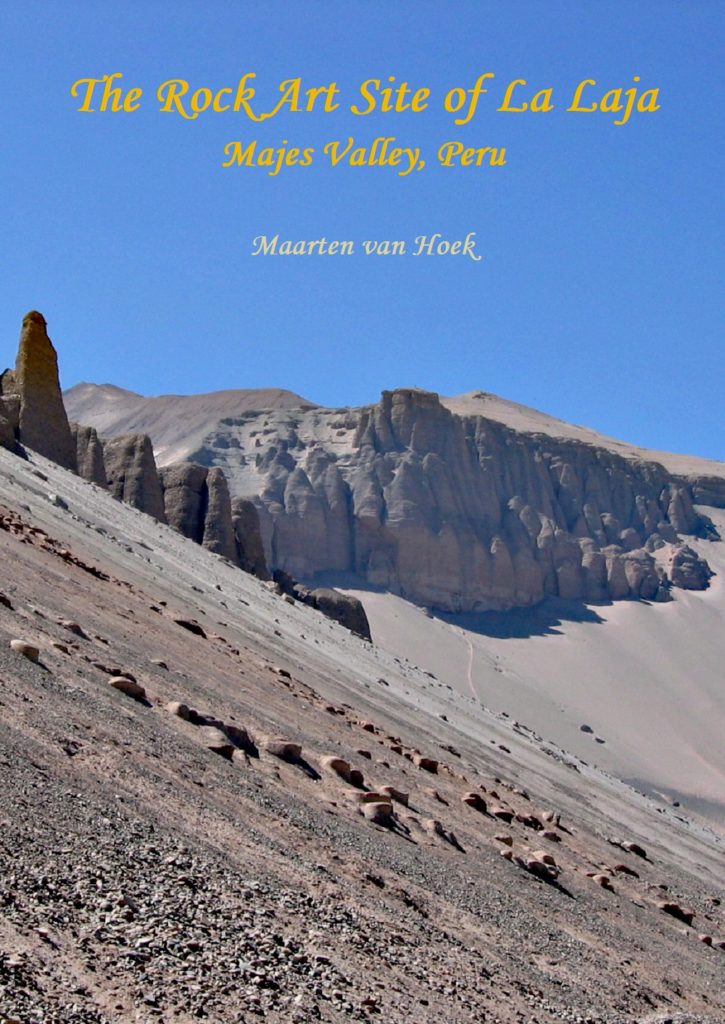
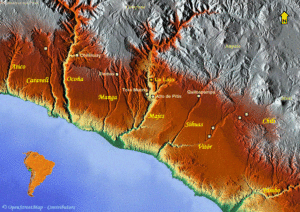
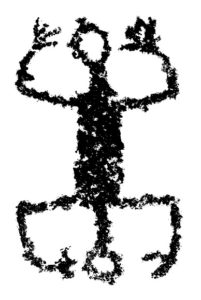
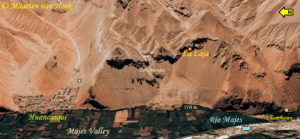
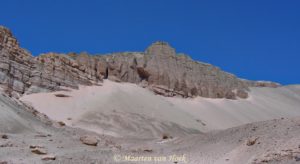
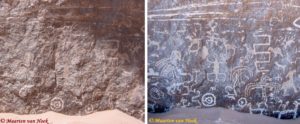
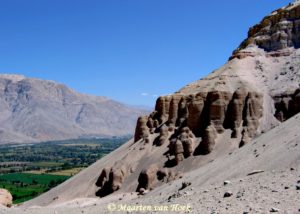
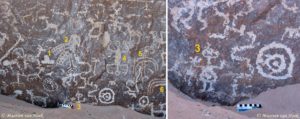




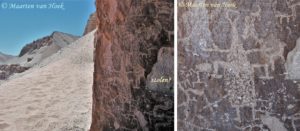
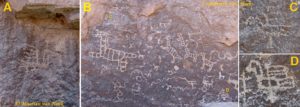














Leave a Reply